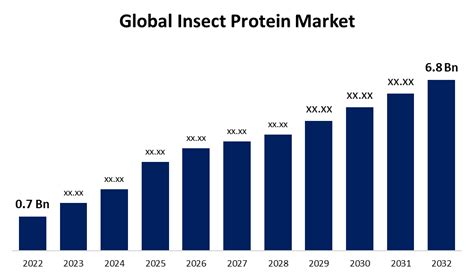Introduction

The insect protein market is poised for exponential growth, driven by a surge in demand for sustainable and nutritious food sources. This comprehensive analysis delves into the key factors influencing market growth, explores emerging trends, and provides insights into untapped opportunities.
Market Dynamics
Drivers
Soaring Food Demand:
– The growing global population and increasing affluence are amplifying the demand for protein-rich foods.
Sustainability Concerns:
– Insect farming offers a sustainable alternative to traditional animal agriculture, reducing greenhouse gas emissions and land use.
Nutritional Value:
– Insects are a rich source of protein, amino acids, and essential nutrients, making them a promising ingredient for human and animal feed.
Restraints
Regulatory Challenges:
– The regulatory landscape governing insect-based food varies across jurisdictions, requiring manufacturers to navigate complex approval processes.
Consumer Perception:
– Some consumers may harbor negative perceptions about consuming insects, creating a barrier to market adoption.
Market Growth Projections
According to a report by Market Research Future, the global insect protein market is projected to grow at a CAGR of 24.6% from 2023 to 2030, reaching a value of over USD 1.5 billion by 2030. This growth is attributed to increasing awareness of the environmental and nutritional benefits of insects.
Regional Analysis
The Asia-Pacific region is anticipated to dominate the market, driven by the rising demand for sustainable protein sources in populous countries like China and India. Europe and North America are expected to follow suit due to increasing government support for insect farming.
Key Trends
Novel Applications:
– Insects are being explored as ingredients in pet food, aquaculture feed, and even cosmetics, creating new market opportunities.
Technological Advancements:
– Innovations in insect farming techniques and processing technologies are improving efficiency and reducing production costs.
Sustainability Initiatives:
– Governments and organizations are promoting insect farming as a sustainable alternative, offering incentives and support programs.
Competitive Landscape
Major players in the insect protein market include Ynsect, Protix, and Entomo Farms. These companies are investing in research and development, expanding production capacity, and establishing strategic partnerships.
Emerging Opportunities
Vertical Farming:
– Controlled environments enable year-round insect production, ensuring consistent supply and quality.
Insect-Based Food Products:
– The development of innovative insect-based food products, such as flour, powders, and snacks, can enhance consumer acceptance.
Pharmaceutical Applications:
– Insect-derived compounds are being investigated for their potential in drug development and nutraceutical formulations.
Common Mistakes to Avoid
Ignoring Regulatory Requirements:
– Failure to comply with regulations can lead to delays and legal penalties.
Underestimating Consumer Perception:
– Ignoring consumer concerns about insect consumption can hinder market growth.
Overestimating Market Potential:
– Setting unrealistic growth targets can lead to disappointment and financial losses.
FAQs
-
Are insects safe to eat?
– Yes, insects are generally considered safe for human and animal consumption when produced under controlled conditions. -
How nutritious are insects?
– Insects are a rich source of protein, amino acids, fiber, and vitamins. -
Can insects reduce our environmental footprint?
– Yes, insect farming requires less land, water, and energy than traditional animal agriculture. -
What are the ethical implications of insect farming?
– Ensuring the welfare of insects and mitigating any potential environmental risks is crucial.
Reviews
-
“Insect protein is a revolutionary food source that offers sustainability, nutrition, and economic benefits.” – Dr. Mark Post, CEO of Mosa Meat
-
“The regulatory landscape for insect-based food is rapidly evolving, creating new opportunities for innovation.” – Emily Leproust, Research Analyst at Entomo Farms
-
“Insect farming can play a vital role in addressing the challenges of food security and environmental sustainability.” – Dr. Maria Elena Lopez-Huertas, Professor at the University of California, Davis
-
“As a consumer, I am eager to explore insect-based food products that are nutritious, sustainable, and delicious.” – Carla Morales, Food Enthusiast
Conclusion
The insect protein market is poised for explosive growth, driven by a confluence of factors including soaring food demand, sustainability concerns, and technological advancements. By addressing key challenges such as regulatory approvals and consumer acceptance, stakeholders can unlock the full potential of this transformative industry. As the market continues to mature, novel applications, emerging trends, and ongoing research will pave the way for a sustainable and nutritious future.
Tables
Table 1: Global Insect Protein Market Share by Region (2023-2030)
| Region | Market Share |
|---|---|
| Asia-Pacific | 55% |
| Europe | 25% |
| North America | 15% |
| Rest of the World | 5% |
Table 2: Key Market Players and Their Strategies
| Company | Strategy |
|---|---|
| Ynsect | Expansion of production capacity |
| Protix | Partnerships with food manufacturers |
| Entomo Farms | Investment in research and development |
Table 3: Emerging Applications of Insect Protein
| Application | Examples |
|---|---|
| Pet Food | Protein supplements, kibble |
| Aquaculture Feed | Fish feed, shrimp feed |
| Cosmetics | Insect-derived chitin in moisturizers |
Table 4: Common Mistakes to Avoid in Insect Protein Market
| Mistake | Consequences |
|---|---|
| Ignoring Regulations | Legal penalties, delays |
| Underestimating Consumer Perception | Market stagnation |
| Overestimating Market Potential | Financial losses, disappointment |





















